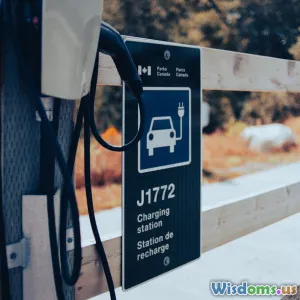
What Makes Electric Vehicles Safer or Riskier Than Gas Cars?
9 min read Explore how electric vehicles compare to gas cars in safety, uncovering unique risks and compelling benefits. (0 Reviews)
What Makes Electric Vehicles Safer or Riskier Than Gas Cars?
Electric vehicles (EVs) have surged in popularity, driven by their promise of reducing carbon emissions and fostering energy independence. Yet as we raise these zero-emission vehicles on the podium, an important question demands scrutiny: How do EVs stack up against traditional gas cars when it comes to safety? While both vehicle types share fundamental safety features, the distinct powertrains and designs foster different risk profiles. This article explores these nuances in detail, armed with data and expert insight, to shed light on the safety prospects and concerns surrounding electric mobility.
Understanding the Basics of Vehicle Safety
Before contrasting EVs and gas-powered vehicles, it's essential to recognize the core principles that govern automotive safety. Historically, safety touches on:
- Crashworthiness — the vehicle’s ability to protect occupants during a collision.
- Post-crash risks — such as vehicle fires or electrocution.
- Active safety technologies — which help prevent accidents altogether.
Gauging safety involves laboratory crash tests (e.g., those from NHTSA and IIHS), real-world accident statistics, and technology assessments.
Crash Safety: Current Insights
Structural Differences and Impact Absorption
EVs differ significantly from gas cars in design because they contain large, heavy battery packs usually housed under the floor. This layout lowers the center of gravity, potentially enhancing stability and reducing rollover risk. For instance, the Insurance Institute for Highway Safety (IIHS) notes that Tesla vehicles with low centers of gravity have fewer rollover incidents compared to some similarly sized gasoline vehicles.
Furthermore, the battery enclosure is typically reinforced to withstand impacts, acting as a rigid structural spine. This flattening of risks due to a lower rollover rate is a definite safety advantage. However, the extra battery weight sometimes demands sturdier chassis components, which can marginally influence crash dynamics.
Real-World Crash Data
A 2021 report analyzing crash information from California, the U.S. state with the largest population of EVs, suggested that electric vehicles had a slightly lower fatal crash rate per miles driven than equivalent gas-powered cars. For example, Tesla's Model 3 reported fewer fatalities compared to similar mid-sized gasoline sedans, attributed partly to advanced driver-assist features enriched by software updates exclusive to EVs.
Still, the absence of long-term extensive crash data for many EV models tempers robust conclusions.
Fire Risks: Myths and Realities
Fire safety is one of the most scrutinized areas for EVs. Skepticism stems from highly publicized cases of battery fires, often sensationalized by media. But what do statistics reveal?
Gasoline vs. Battery Fire Incidences
Analyses by the National Fire Protection Association (NFPA) reveal that traditional gasoline cars ignite far more frequently than EVs. The U.S. Bureau of Transportation Statistics indicates that gasoline vehicle fires occur approximately once in every 1,144 motor vehicles annually, whereas EV fire incidents are far less common on a per-vehicle basis.
Causes and Containment of Battery Fires
While lithium-ion batteries can catch fire due to thermal runaway — a chain reaction triggered by internal chemical failures — advances in battery management systems (BMS) have reduced these incidents. Manufacturers employ sophisticated cooling, separators, and automatic discharging protocols to prevent overheating.
Nonetheless, EV battery fires require different firefighting tactics, like copious amounts of water and longer cooling times. Fire departments have undergone specialized training to address these new challenges effectively.
Electrical Hazards: Safe by Design
Concerns about electrocution risk in crashes are understandable but often overstated.
Battery Isolation and Automatic Safeguards
EVs are engineered with multiple redundancies. In a collision, the high-voltage battery isolates automatically to cut off power flow. Built-in sensors, circuit breakers, and insulated components reduce shock hazards for occupants and first responders.
The Society of Automotive Engineers (SAE) provides strict standards (like the J1766 standard) specifying protocols for warning stickers, disconnects, and emergency handling.
While a residual risk remains in severe crashes with battery damage, no significant pattern of electrocution injuries related to EVs has emerged in accident reports.
Technology and Active Safety: Next-Level Prevention
Electric vehicles often come bundled with state-of-the-art driver-assist features, like Autopilot, adaptive cruise control, automatic emergency braking, and collision avoidance systems.
Software Updates and Real-Time Enhancements
Traditional gas cars with less frequent system overhauls lack the ease of OTA (Over The Air) updates that EVs continually benefit from. This capacity for rapid improvement enables EVs to stay ahead in safety standards dynamically — repairing bugs and introducing new safety algorithms remotely.
Impact on Accident Rates
Studies, such as those by Tesla and NHTSA, have credited their vehicles’ advanced safety suites with reducing accident frequency. Tesla data from their fleet showed a 40% improvement in miles driven per accident after introducing Autopilot features.
Other automakers, including Audi, Ford, and Hyundai, are rapidly incorporating equivalent systems into their electric lineups, reflecting a wider industry trend.
Psychological and Behavioral Factors
Despite the tangible safety perks, the perception of EV safety influences driver behavior.
A study conducted by the AAA Foundation suggested that some drivers overestimate the safety of EVs, potentially leading to more aggressive driving. Conversely, fears about battery fires can result in overly cautious approaches that may impact driving patterns.
Education about realistic safety profiles is crucial to optimizing how consumers interact with new automotive technologies.
Conclusion: A Balanced Safety Perspective
Electric vehicles fundamentally shift certain safety paradigms thanks to battery placement, design innovations, and cutting-edge technology. Lower rollover chances and fewer fire incidents potentially make EVs safer on multiple fronts. Meanwhile, concerns around battery fires and electrical risks, though valid, are well-managed with modern engineering controls and emergency protocols.
At the same time, both electric and gasoline vehicles demand respect on the road—continued vigilance, proper maintenance, and adherence to safety laws remain paramount. As EV technology matures and datasets grow richer, the automotive industry advances toward safer, greener transportation.
For consumers, understanding these nuanced safety factors fosters informed choices. And for developers and policymakers, it highlights where innovation and regulation can further close gaps, ensuring electric vehicles not only sustain but elevate our collective safety standards in the accelerating shift away from fossil fuels.
References:
- Insurance Institute for Highway Safety (IIHS) Reports
- National Fire Protection Association (NFPA)
- U.S. Bureau of Transportation Statistics
- NHTSA Data & Tesla Safety Reports
- AAA Foundation for Traffic Safety
- Society of Automotive Engineers (SAE) Safety Standards
Engage with the transition—drive electric with awareness and confidence!
Rate the Post
User Reviews
Popular Posts



















